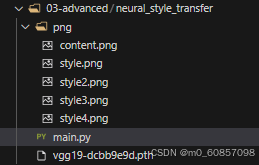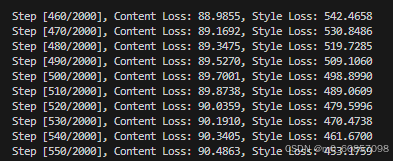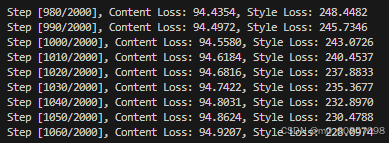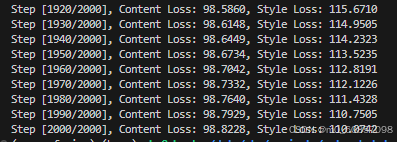准备数据、代码和权重:
代码:
from __future__ import division
from torchvision import models
from torchvision import transforms
from PIL import Image
import argparse
import torch
import torchvision
import torch.nn as nn
import numpy as np
# 设备配置
device = torch.device('cuda' if torch.cuda.is_available() else 'cpu')
def load_image(image_path, transform=None, max_size=None, shape=None):
"""Load an image and convert it to a torch tensor."""
image = Image.open(image_path)
if max_size:
scale = max_size / max(image.size)
size = np.array(image.size) * scale
image = image.resize(size.astype(int), Image.ANTIALIAS)
if shape:
image = image.resize(shape, Image.LANCZOS)
if transform:
image = transform(image).unsqueeze(0)
return image.to(device)
class VGGNet(nn.Module):
def __init__(self):
"""Select conv1_1 ~ conv5_1 activation maps."""
super(VGGNet, self).__init__()
self.select = ['0', '5', '10', '19', '28']
self.vgg = models.vgg19(pretrained=True).features
def forward(self, x):
"""Extract multiple convolutional feature maps."""
features = []
for name, layer in self.vgg._modules.items():
x = layer(x)
if name in self.select:
features.append(x)
return features
def main(config):
# Image preprocessing
# VGGNet was trained on ImageNet where images are normalized by mean=[0.485, 0.456, 0.406] and std=[0.229, 0.224, 0.225].
# We use the same normalization statistics here.
transform = transforms.Compose([
transforms.ToTensor(),
transforms.Normalize(mean=(0.485, 0.456, 0.406),
std=(0.229, 0.224, 0.225))])
# Load content and style images
# Make the style image same size as the content image
content = load_image(config.content, transform, max_size=config.max_size)
style = load_image(config.style, transform, shape=[content.size(2), content.size(3)])
# Initialize a target image with the content image
target = content.clone().requires_grad_(True)
optimizer = torch.optim.Adam([target], lr=config.lr, betas=[0.5, 0.999])
vgg = VGGNet().to(device).eval()
for step in range(config.total_step):
# Extract multiple(5) conv feature vectors
target_features = vgg(target)
content_features = vgg(content)
style_features = vgg(style)
style_loss = 0
content_loss = 0
for f1, f2, f3 in zip(target_features, content_features, style_features):
# Compute content loss with target and content images
content_loss += torch.mean((f1 - f2)**2)
# Reshape convolutional feature maps
_, c, h, w = f1.size()
f1 = f1.view(c, h * w)
f3 = f3.view(c, h * w)
# Compute gram matrix
f1 = torch.mm(f1, f1.t())
f3 = torch.mm(f3, f3.t())
# Compute style loss with target and style images
style_loss += torch.mean((f1 - f3)**2) / (c * h * w)
# Compute total loss, backprop and optimize
loss = content_loss + config.style_weight * style_loss
optimizer.zero_grad()
loss.backward()
optimizer.step()
if (step+1) % config.log_step == 0:
print ('Step [{}/{}], Content Loss: {:.4f}, Style Loss: {:.4f}'
.format(step+1, config.total_step, content_loss.item(), style_loss.item()))
if (step+1) % config.sample_step == 0:
# Save the generated image
denorm = transforms.Normalize((-2.12, -2.04, -1.80), (4.37, 4.46, 4.44))
img = target.clone().squeeze()
img = denorm(img).clamp_(0, 1)
torchvision.utils.save_image(img, 'output-{}.png'.format(step+1))
if __name__ == "__main__":
parser = argparse.ArgumentParser()
parser.add_argument('--content', type=str, default='png/content.png')
parser.add_argument('--style', type=str, default='png/style.png')
parser.add_argument('--max_size', type=int, default=400)
parser.add_argument('--total_step', type=int, default=2000)
parser.add_argument('--log_step', type=int, default=10)
parser.add_argument('--sample_step', type=int, default=500)
parser.add_argument('--style_weight', type=float, default=100)
parser.add_argument('--lr', type=float, default=0.003)
config = parser.parse_args()
print(config)
main(config)
权重来自于
'vgg19': 'https://download.pytorch.org/models/vgg19-dcbb9e9d.pth',
手动添加权重的路径:
开始训练:
python main.py --content='png/content.png' --style='png/style.png'
显存开销:
输入的content.png:
style.png:
最后输出的output-2000.png:








